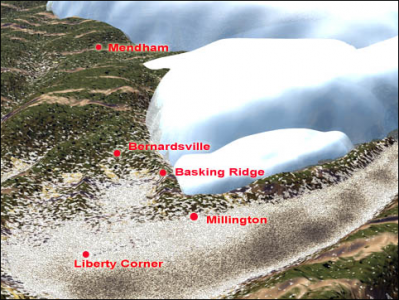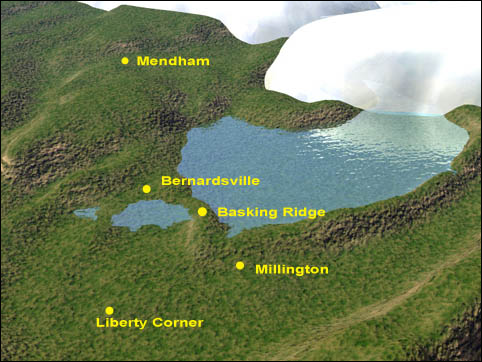
The last glacier to pass through our region did so about 16,000 years ago. As it receded, it left behind piles of rocks and earth as well as the melt water that would shape our present-day landscape.
Did you know that our Great Swamp has not always been a swamp? In fact, the landscape of our region has changed constantly over the course of our planet’s geological history. Here’s the story!
New Jersey’s Great Swamp is nestled within a 55-square-mile natural basin, just 25 miles or so from New York City. It’s a quiet, undisturbed place today. But it wasn’t always that way.
Millions of years ago the continent of Africa collided violently with North America pushing up great mountains to the north and west. Erosion has since cut them down to size.
Later, when Africa broke away, hot molten rock flowed up from the earth’s interior to create the Watchung Mountains that lie to the south and east. Once again, erosion has taken its toll.

Melt water from the last glacier pooled to form Glacial Lake Passaic (approximation shown here). Water from that lake would eventually pierce through the ridge in Millington forming Millington Gorge and the main stem of the Passaic River.
Finally—about 18,000 years ago—a glacier advancing from the north ceased its forward motion and began to melt. The melting glacier left behind a great pile of rock and soil in a line from Chatham to Morristown.
The swamp basin itself was scooped out by the last glacier to pass through our region. That happened some 16,000 years ago. The glacier stopped when it ran into the Watchung Mountains, and the great pile of earth and rocks it pushed in front of it remained after it melted. Today we know that pile of earth and rocks as Basking Ridge!
After the last glacier began to recede, the melt-off from it formed a lake known as Glacial Lake Passaic.
Eventually, the water pressure from Glacial Lake Passaic forced a gap through the ridge in Long Hill and formed the Millington Gorge. As water spill out of the lake, it formed the Passaic River we know today. Almost all of the water that once filled Glacial Lake Passaic was emptied to form the basin we know today as the Great Swamp Watershed.
Our basin is called a watershed because all of the streams that flow within its borders converge in a a single body of water—-the Great Swamp itself. Just like it did when Glacial Lake Passaic began to drain, water from the Great Swamp we know today continues to empty into the Passaic River at Millington Gorge. The Passaic carries it for about 80 miles until the river reaches Newark Bay on the Atlantic coast.